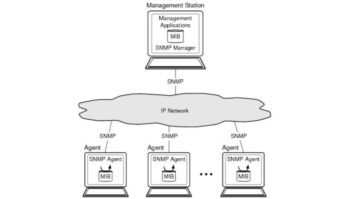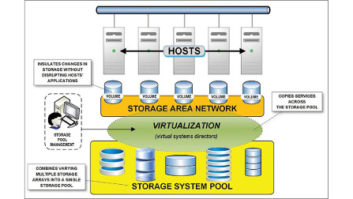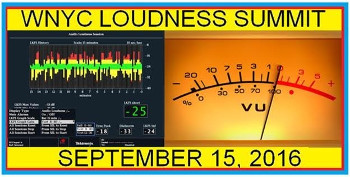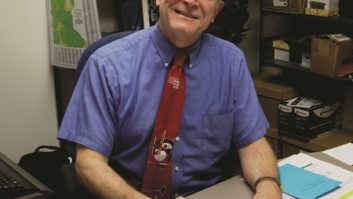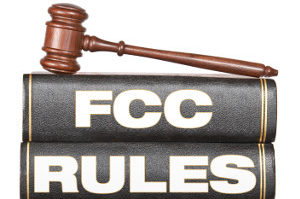The following terms appear in Dan Slentz’s eBook article about building an LPFM. They are explained in only basic terms here for readers who may not be familiar with them. Detailed definitions can be found via numerous online resources.
STUDIO TECH RACK TERMS
AoIP or Audio over Internet Protocol — Similar to VoIP (Voice over Internet Protocol in telephone systems), Audio over Internet Protocol is the latest in audio board technologies, where digital uncompressed audio is delivery over a single Cat-5e/6 cable between studios and gear. The audio characteristics are of full CD quality and noise/interference are better rejected by twisted pair audio than traditional wiring. Additionally (and unlike AES digital audio or balanced analog audio), control of equipment can be made through the AoIP interface, and cable and connectors (RJ-45) are both less expensive than traditional wiring.
Cat-5e / Cat-6 — This is the cabling use for computer connections (including AoIP). Cat-5 is the older standard that is steadily being replace by Cat-5e and/or Cat-6. Though 5e or 6 cable can be used for video (with the use of baluns) or telephone, it’s most frequently used in computer connections or for data.
Mix-Minus — The ability to give a phone caller who is on-the-air the sound out of the audio console (the “mix) minus their own voice (the “minus”). Without this ability, you would create a “loop of sound” (callers voice to board to caller to board to caller… etc.) creating a feedback loop.
Remote Broadcasts — Having a remote audio origination point other than your studio. This could be coverage of a high school football game to a broadcast from an event like a county fair or festival.
RJ-11, RJ-12, R-J45 — These are the “Registered Jacks” for phone and computer. The RJ-11 and RJ-12 (4 and 6 wire) are typically used for telephone connections while the RJ-45 (8 wire) is typically used for connecting computers and in AoIP connections.
RPU or Remote Production Unit (or Radio Propagation or Programming Unit) — This is a system for remote broadcasting where a wireless transmitter (licensed) sends audio back to the station for live remote broadcasting. Over the past years, this gear has often been replaced with cell phone technology, streaming, and digital audio interfaces (or a combination)
STL or Studio to Transmitter Link — A system, traditionally licensed over-the-air wireless, used to get audio from your studio to remote transmitter location
Stream Encoder/Decoder — Instead of traditional STLs, many stations have gone to digital stream encoders using wireless systems and wired broadband (like DSL or cable modem) to get their audio from the studio to transmitter site, plus to remotely control the transmitter site gear.
TSL or Transmitter to Studio Link — Sometimes it is necessary to get return audio to the station from the transmitter site (for instance, when you have a RPU unit on your tower), this traditionally was another piece of wireless gear.
TRANSMITTER CHAIN TERMS
Antenna or FM Transmitting Antenna — This is the entire fixture that makes up your antenna. It could consist of one or many “bays.” Each bay adds to the antenna’s effectiveness in extending signal reach.
Audio Logger — A piece of gear (from tape-based cassette to digital recorder) used for recording your on-air programming. It can be used to prove (if questioned about content later) what was played or said on the air. The logger can be set-up to just record times when the microphone is open (turned on), or all audio. Typically the logger audio quality (when recording ALL content) is a lower-resolution version so it doesn’t use up as much hard drive space.
Bay or Antenna Bay — In reference to an antenna, this is one of the “elements” or parts that make up the entire antenna. The antenna could have a single bay (which looks like a V-shaped pipe, a T-shaped pipe, or a C-shape with a twist pipe), or it could have numerous bays. The more bays, the more gain, plus greater cost and heavier weight on the tower. But the more bays, the less power (TPO) your transmitter will need to put out to hit your effective radiated power (ERP)
Back-up Audio Source — For any number of reasons, your transmitter could lose the incoming audio (even if the transmitter is located at your station). Power could go out in your studio. Your automation could fail. The audio board power supply could go out. And for a remotely located transmitter, losing your STL or audio stream to the transmitter is always a possibility. When this happens, there is equipment that can quickly replace that lost audio with “back-up audio”. Some transmitters now include internal audio players for loss of incoming audio.
Coax — Line carrying the signal from your transmitter to antenna. Minimum for an LPFM would be half-inch (diameter); the smaller the size, the more line loss but the lower the cost.
EAS / CAP or Emergency Alert System & Common Alerting Protocol — LPFMs are required only to have the decoder in place for rebroadcast of emergency alert announcements.
ERP or Effective Radiate Power — The power with which the station is authorized to broadcast. This is NOT the transmitter power, rather the power that is generated when you factor in additional elements such as line loss, antenna gain and height above average terrain (HAAT).
FCC or Federal Communications Commission — The government agency that oversees broadcasting and electronic communication. At the direction of Congress, it set out the rules and system that allowed the expansion of the LPFM service.
Fold Back — Expression to indicate a transmitter is lowering its power automatically. This is done if it sees a high VSWR or there is another problem affecting the transmitter.
HAAT or Height Above Average Terrain — This is the center of our antenna above the average terrain. This is not simply where the antenna sits in relation to the ground below the tower, but the height above the terrain when it is averaged for the entire area.
Line Loss — The amount of power or signal your coax cable loses naturally over the length of the cable being used.
LPFM — Low-power FM is a “community class” of broadcaster. Currently LPFMs are licensed with an ERP of 100 watts. A prospect for even a lower (10 watt) version is apparently no longer being considered, though a higher-power version (LPFM 250) at 250 watts has been debated.
kW or Kilowatt — A measurement of power. For instance, in radio a transmitter that is 1,000 Watts can also be said to operate at 1 kW. The prefix “kilo” means one thousand.
Line Loss — The amount of power or signal your coax cable loses naturally over the length of the cable being used.
RDS or RBDS or Radio Broadcast Data Service — This is auxiliary data that your transmitter can put out (via a subcarrier or “SCA”) that includes program information accessible by new RBDS equipped radios. That data might include your format, song title and artist, and other information. It can be as simple as a static display of your call letters and slog, or more involved with data that changes.
RF or Radio Frequency — This is the invisible power through the air that IS the signal that the consumer’s antenna received that carries our signal.
RPU or Remote Pickup Unit — Like the STL, this is the expression for the licensed gear (transmitter/receiver) that has frequently been used for “live remote broadcasting.” The traditional radio RPU required a special radio (in a van or portable), antenna, line-of-site between the remote transmitter and receiving system (usually on a tower at the station or on the station’s main broadcast tower. The audio from the RPU would then be fed to the on-air console. These could be used for news, sports programming, or any place from where the station wanted to do a remote broadcast. More recently traditional RPUs have been replaced by stream encoders and cellular systems.
SCA, Subcarriers or Subsidiary Communications Authority — This can be an additional “service” or feature that you broadcast through your FM transmitter. Services like background music and reading services for the blind, which rely on specialized radios — as well as RDS data to display song title/artist on RDS-equipped radios — are generated via “SCAs.” No special licenses are needed for these services and they allow for greater audio modulation levels on your primary service (see above) up to 110 percent modulation.
STL or Studio to Transmitter Link — When a transmitter is located at an area away from the studio, the traditional piece of equipment that “privately” sends your signal from the studio to transmitter is referred to as the station’s STL. These can be expensive and require special licensing. Stations now sometimes use special private stream encoding systems in place of traditional STL.
TPO or Total Power Output — The actual power that transmitter is emitting. If measured, this would be directly at the output of the transmitter. This is NOT the power we are licensed for, rather the power the transmitter must operate to reach our licensed power, which is called ERP, or Effective Radiated Power.
VSWR / VSR or Variable Standing Wave Ratio — The amount of power reflected back into the transmitter either by natural elements like freezing rain or by antenna or coax failure. VSWR can be damaging to the transmitter.
